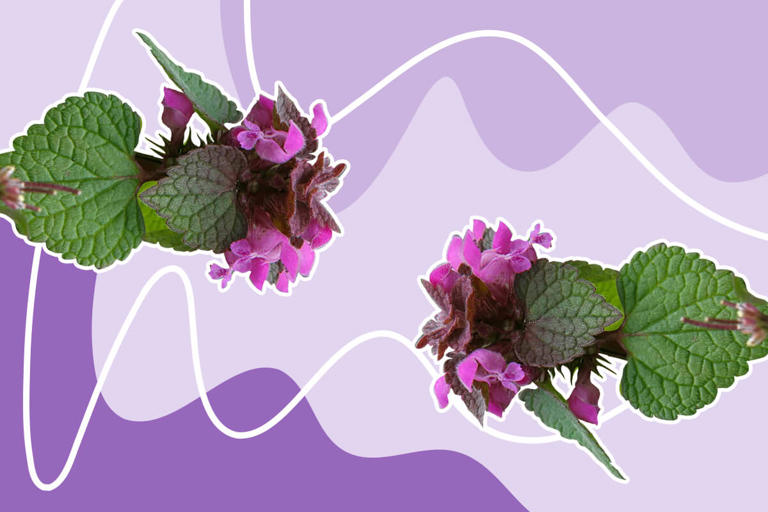Top 7 Uses and Benefits of Dead Nettle Plants













Top 7 Uses and Benefits of Dead Nettle Plants
The flowers of the dead nettle plant (Lamium) have been utilized for centuries in alternative medicine. Some other common names for this plant are white nettle, white dead nettle, and white archangel. Although there is limited scientific data on dead nettle’s therapeutic effects, it’s long been utilized for various reasons in folk medicine. In this guide, I’ll run you through the potential benefits of dead nettle in traditional medicine.
- Dead Nettle’s Most Common Medicinal Applications:
- 7 Medicinal Properties of Dead Nettle
- Current Scientific Research on Dead Nettle
Dead Nettle’s Most Common Medicinal Applications:

Dead nettle plants may produce anti-inflammatory effects and were historically used for treating swelling. Instances of rashes, burns, and insect bites can all benefit from the topical application of dead nettle. Dead nettle has also been used to staunch bleeding due to its hemostatic qualities. When used topically, it has been shown to help wounds clot and cease bleeding.
Additionally, dead nettle has been used in herbal medicine as a diuretic — a substance that causes one to urinate more often. Many people have used it for this purpose because they’ve heard that it helps the kidneys filter waste from blood.
Dead nettle also has a long history of use in folk medicine for the relief of menstrual cramps and related symptoms. Heavy monthly flow, cramping, and other symptoms associated with these conditions were thought to be alleviated by the astringent effects of dead nettle on the uterus.
Herbalists have traditionally employed dead nettle to aid respiratory functioning. Historically, the plant was ingested orally to ease bronchial and chest congestion as well as coughing.
Dead nettle has also been used for its ability to help digestion. In addition to relieving digestive symptoms, including indigestion and bloating, it was also thought to have modest laxative traits.
Although dead nettle has been used traditionally for medicinal purposes, there’s a lack of high-quality research that can attest to its safety and effectiveness. If an individual has a preexisting health concern or is on any prescriptions, they should talk to their doctor before taking any kind of herbal product, including dead nettle.
7 Medicinal Properties of Dead Nettle
1) Dead nettle has a long history of use as an herbal medicine. Traditional use and anecdotal evidence indicate various possible medicinal benefits, but scientific study of its therapeutic characteristics is lacking. Some of dead nettle’s purported health benefits and traditional applications are described more in depth below.
2) In addition, these plants have long been utilized for their anti-inflammatory effects. It was put on an affected area to alleviate pain from rashes, burns, and bug bites. Crushed leaves of the plant were used as a poultice to reduce swelling and speed healing.
3) Dead nettle’s hemostatic characteristics have made it helpful in slowing or stopping bleeding. In the past, it was often used on injured areas of the body to speed up the clotting process when administered topically to wounds. Dead nettle’s astringent qualities were thought to aid in reducing bleeding by contracting blood vessels close to a wound.
4) Dead nettle has long been utilized for its diuretic properties. It was thought to stimulate urination, which would help the body flush out harmful substances. This diuretic effect was believed to be beneficial to the kidneys and urinary tract.
5) Dead nettle also has a long history of use as a menstrual health aid. Heavy monthly flow, period cramps, and other symptoms associated with this condition were thought to be alleviated by the plant’s astringent action on the uterus. It was not uncommon for women to drink a tincture or tea made from dead nettle plants to help control their periods.
6) Dead nettle has long been used in traditional herbal medicine to promote healthy breathing. Historically, it was taken by mouth to ease bronchial and chest congestion and to control coughing. It was common practice to drink tea made from dried nettles to improve respiratory health and ease respiratory symptoms.
7) Dead nettle was also traditionally utilized for its ability to help digestion. It was traditionally used to treat various digestive issues, including indigestion, gas, and constipation, on the assumption that it had moderate laxative effects.Dead nettle was sporadically used in infusions or decoctions expressly to aid digestion.
Although dead nettle has been used traditionally for many years, there’s currently little scientific data to support its therapeutic efficacy or safety. Traditional applications may have some validity, but further study is required to identify the active chemicals responsible for any purported health benefits.
Current Scientific Research on Dead Nettle
The scholarly literature on dead nettle and its possible medicinal uses is very limited. There’s a relative lack of new research explicitly focused on dead nettle; most recent studies have instead examined other members of the Lamium genus or particular characteristics of the plant. Nevertheless, listed below are some broad details on recent research into Lamium species and specific substances found in dead nettle.
1) Several papers have discussed the anti-cancer and anti-tumor effects of Lamium species, including one published in Medicine in 2012 that showed promising effects of extracts of Lamium album from either natural sources or grown by micropropagation technique. The most powerful effect was obtained by treatment with combined methanol/chloroform extracts.
2) In 2021, researchers looked at how well an ointment formulation containing Lamium album extract healed wounds; the results were published in the Journal of Medicinal Plants. When tested on rats, the outcomes were encouraging, indicating the possibility of use in wound healing by promoting wound closure and tissue regeneration.
3) Other research has looked at the antibacterial properties of Lamium album. The antibacterial efficacy of Lamium album extracts against different bacteria and fungi was studied in a 2013 paper published in the African Journal of Traditional, Complementary, and Alternative Medicine. The findings showed antibacterial activity, suggesting a possible role for Lamium album extracts in the treatment of illnesses of microbial origin.
4) More recently, in 2019, researchers discussed the antioxidant and anti-inflammatory effects of Lamium plants and reported favorable findings in Molecules. These characteristics point to a possibility of lowering inflammatory and oxidative stress levels, both of which are linked to a multitude of health problems.
5) Other research on the antioxidant and anti-inflammatory capabilities of certain Lamium species has also shown promising results. For instance, in 2019, Lamium album extract was tested for its anti-diabetic effects in diabetic rats, and the results were reported in Pharmaceutical Sciences. Improvements in glucose metabolism were cited as a mechanism by which the extract exhibited considerable anti-diabetic effects in the research.
A quick note…
Although they come from the natural world, plant medicines can be as dangerous as pharmaceuticals when it comes to potential drug interactions or adverse side effects. While many flowers are generally considered safe, it’s always a good idea to do your own research and check with a doctor before taking any plant medicine internally—especially if you’re pregnant, breastfeeding, or currently on any medication.
Wrapping Up – The Benefits of Dead Nettle in Traditional Medicine
Further study is required to thoroughly understand the effectiveness, methods of action, and possible adverse effects of Lamium species like dead nettle, although the above studies do offer some insights into their potential medicinal uses in the future. For now, at least from a traditional and anecdotal medicinal point-of-view, the benefits of dead nettle appear to be valid and merit further scientific study.
Further Reading: Dead nettle meaning and symbolism in the language of flowers.
The post Top 7 Uses and Benefits of Dead Nettle Plants appeared first on Petal Republic.
No thoughts on “Top 7 Uses and Benefits of Dead Nettle Plants”
Articles - Most Read
- Home
- LIVER DIS-EASE AND GALL BLADDER DIS-EASE
- Contacts
- African Wholistics - Medicines, Machines and Ignorance
- African Holistics - Seduced by Ignorance and Research
- African Wholistics -The Overlooked Revolution
- The Children of the Sun-3
- Kidney Stones-African Holistic Health
- PART ONE: DIS-EASE TREATMENT AND HEALTH-3
- 'Tortured' and shackled pupils freed from Nigerian Islamic school
- The Serpent and the RainBow-The Jaguar - 2
- PART ONE: DIS-EASE TREATMENT AND HEALTH-4
- PART ONE: DIS-EASE TREATMENT AND HEALTH-2
- King Leopold's Ghost - Introduction
- PART ONE: DIS-EASE TREATMENT AND HEALTH-5
- African Wholistics - Medicine
- Menopause
- The Mystery System
- PART ONE: DIS-EASE TREATMENT AND HEALTH-6
- The Black Pharaohs Nubian Pharaohs of Ancient Egypt
Who's On Line?
We have 157 guests and one member online
Ad Agency Remote
Articles - Latest
- New genetically-modified purple tomato made with DNA created by scientists
- Pili Nuts Nutrition Facts and Health Benefits
- Why you’re hungry all the time – and what you can do about it
- The hidden health hazards of vegan sausages
- The living hell of insomnia – and the solutions that don’t work
- What Is Mizuna? Top 6 Benefits of This Supergreen
- 11 Proven Health Benefits of Ginger
- A daytime nap is good for the brain
- Ancient Roman Medicinal Plant Was Feared Due to 'Insanity, Giddiness' Effects: Study
- Shock of the old: 10 scandalous vintage medicines – from asthma cigarettes to cocaine wine
- What Happens to Your Body When You Eat Blueberries Every Day
- Magnesium is brilliant for sleep and cramps - here's how to get enough of it
- How psychosomatics works and what our body tells us
- Atrial fibrillation linked to high mortality and hospitalization rates, UQ study shows
- Ask A Nutrition Professional: What Are The Health Benefits Of Herbal Tea?
- Study reveals human gut plasmid with biomarker potential
- What Makes Spinach So Healthy?
- 'Why don't we recognise the importance of men in care professions?'
- Burdock – 7 Amazing Benefits & Nutrition Facts



